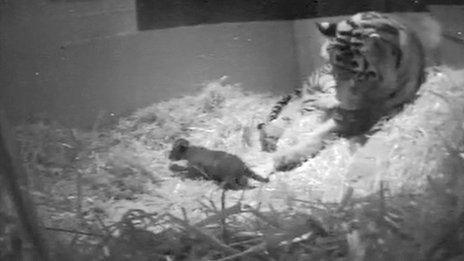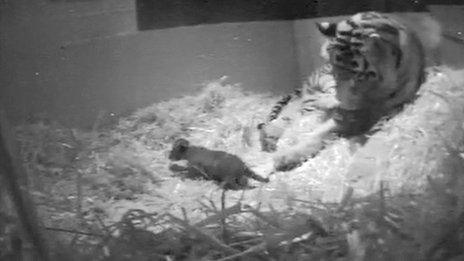London Zoo 'was well aware' of tiger death risk
- Published

Melati (seen here with one of her cubs) was mauled to death by the more powerful male
Keepers were "well aware" of the risks of introducing two Sumatran tigers before the female was killed by her potential mate, London Zoo has said.
The male, Asim, killed long-term resident Melati on Friday, 10 days after he was brought over from Denmark.
Malcolm Fitzpatrick, senior curator of mammals, said introductions of large predators were "high risk" but it was "important they are moved around".
The zoo is part of breeding programme for the critically endangered mammals.
Ten-year-old Melati, who had been at London Zoo since 2012, was mauled by Asim shortly after they were introduced and could not be saved, despite the efforts of staff.

Asim (pictured) had been matched with Melati through the European Endangered Species Programme
The zoo had hoped the pair would be compatible as their previous male tiger, Jae-Jae, sired seven cubs with Melati before he was moved to French zoo Le Parc des Félins, on 30 January.
Mr Fitzpatrick told the BBC that while the pair had been "very well bonded... it is important we move them round the zoos as part of the genetic diversity that we need to ensure the population is healthy".
There are thought to be only 300 Sumatran tigers left in the wild.

Jae Jae was moved to France last month
Speaking about Asim's condition, Mr Fitzpatrick said the tiger had been through a "traumatic event" and suffered minor injuries, which were being "monitored".
He added that the seven-year-old was "sociable" at his previous home where he had "been introduced in an even shorter time to the female there," but "occasionally incidents can happen in zoos with established pairs, and in the wild".
Speaking about the future of the programme, he said the zoo hoped to have another breeding pair of tigers and would use the death to "evolve" and "learn" for future introductions.

Tiger facts
Sumatran tigers are the smallest of the five tiger subspecies and have the narrowest black stripes
The roar of a tiger can be so loud that it can be heard from two miles away (3.2km)
A tiger can bite down with the force of 1,000lb (450kg)
From sitting down, a tiger is able to leap forward 33ft (10m)
Fossils found in China show tigers could have been alive two million years ago
Source: ZSL London Zoo
- Published8 February 2019

- Published30 June 2016

- Published28 March 2014

- Published15 October 2013

- Published2 October 2013

- Published18 October 2012
